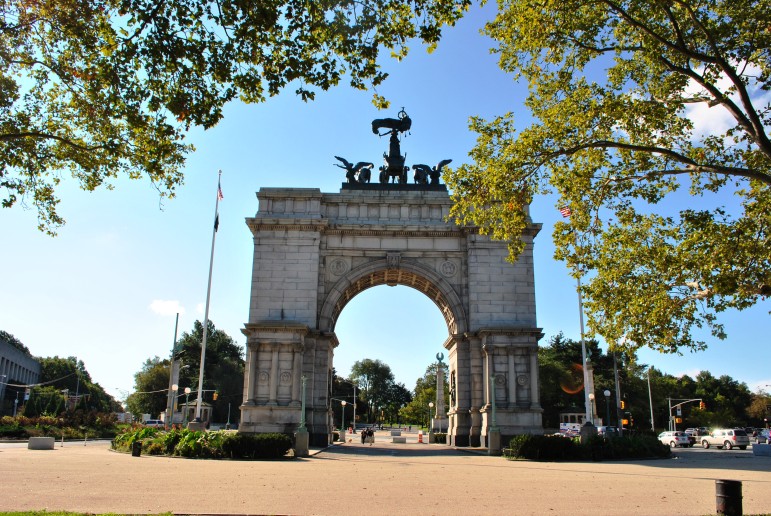
Elisa Rolle
Today is the 150th anniversary of General Lee’s surrender, the event that marked the beginning of the end of the Civil War. Snuck up on you, didn’t it? If you’re like me, every year you plan to get your “End of the Civil War” cards into the mail on time, and do all your Appomatox Courthouse-related shopping early so as to beat the crowds, but you end up waiting until the last minute. And now you have to scramble to figure out how to mark a rather important date in history for the United States and New York itself.
Luckily, New York City is dotted with memorials to the war and the often bushy-faced men who orchestrated it. Some are tucked in corners of the city you may have never visited, while others are familiar if overlooked parts of the visual background of your daily life. Here are a few choice ones:
Grand Army Plaza: This magnificent structure adjacent to Prospect Park is really several memorials in one. The arch is dedicated to soldiers and sailors, and it includes a bronze relief of President Lincoln. Nearby are statues of Generals Warren and Slocum. (And yes, he’s the same Slocum after which the ill-fated steamship was named.)
Statue of Sherman: Manhattan has a Grand Army Plaza, too, at the corner of 5th Avenue and 59th Street, best known for its gold statue of William Tecumseh Sherman, know for his March to the Sea and for coining the phrase “War is hell.” The female figure in the statue is Victory.
Grant’s Tomb: Yes, Grant is buried there (and so is his wife). But old riddles aside, this is a graceful and rather stunning monument to the man who, despite deep personal flaws, led the Union to victory and accepted General Lee’s surrender a century-and-a-half ago.
Clara Barton bust: If they made a memorial to neglected memorials in New York City—which, admittedly, would be a little redundant—the Hall of Fame of Great Americans at Bronx Community College would be in there. Among several Civil War figures memorialized there is Clara Barton, founder of the Red Cross, whose nursing saved countless lives during the conflict, during which she came to be known as “the Angel of the Battlefield.”
Flushing Civil War Monument: This simple memorial is powerful mainly for its text, which lists the names of people from what was then the village of Flushing who died in the war. There were 85.
Soldiers and Sailors Memorial: This monument combines an impressive design—its 100 feet tall—with a single line of text and a dramatic view of the river.
Monitor Monument: This slightly abstract memorial remembers neither a soldier nor a general but rather an inventor and his machine: John Ericsson and the Monitor, the ironclad warship he built in Greenpoint as an answer to the Confederacy’s proto-submarine, the Merrimack. The Monitor and Merrimack (actually the Virginia, a separate ship built using elements of the Merrimack, a ship built by the U.S. Navy before the war and captured by the rebels after the start of the Civil War) fought to a draw in the 1862 Battle of Hampton Roads, but by thwarting the South’s best shot at the Union navy, Ericsson’s ship helped preserve a key northern advantage.
Bronx River Civil War Soldier: This simple, lonely figure used to stand on a pedestal in the middle of the Bronx River but now guards the Valentine-Varian historical house on Bainbridge Avenue next to Williamsbridge Oval Park. There’s no scale, grandeur, color or fame to the piece or its subject, and that’s its selling point. It’s just a dude with a gun who looks like he’s cold and would rather be somewhere else.
Staten Island Civil War Memorial: “Sacred to the memory of our defenders, the noble and gallant men who died in the late Civil War.” Another understated memorial to the named dead.
Frederick Douglass Memorial: It’d be a crime to honor the sacrifices of the Civil War without recognizing the people who, through great courage and skill, lent the war the moral cause that makes it worth remembering. The memorial to Douglass at the northwest corner of central park is an impressive tribute to one of abolitionism’s most stirring voices.
These statues and monuments are a counterpoint (though not a cure) to the other, far less glorious aspects of New York’s role in the civil war. The city’s mayor during the first war years, Fernando Wood, was an outspoken Southern sympathizer who wanted New York to secede so it could keep profiting from the cotton trade. The draft riots of 1863, in which white, working-class anger over unjust aspects of the Union’s draft system morphed into a murderous race riot, remain the worst such uprising in American history.
Those unsavory facts, along with the quiet soldier on Bainbridge Avenue or the names in Flushing, are part of the story that began to end 150 years ago today.









2 thoughts on “Today is the Day to Become a New York City Civil War Buff”
I grew up in Kensington, Brooklyn. A long since demolished old house on my block was built by the then-owners grandfather who was a Civil War veteran. I live on SI now and a few Civil War veterans are buried in Moravian Cemetery.
Appomattox’s Bells are still ringing. Can you hear them? http://www.seandavidsmith.blogspot.com/2015/04/appomattox-bells-are-still-ringing-150.html